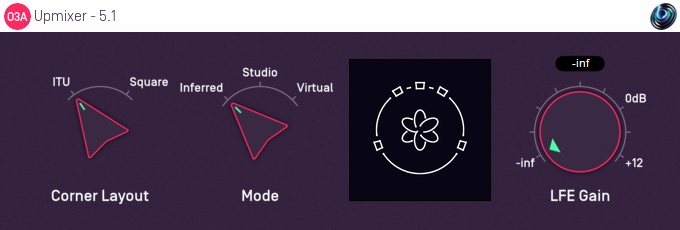O3A Upmixer - 5.1

Host Support
| Host Type | Support |
|---|---|
| AAX | Yes |
| VST2 | Yes |
Audio
| Channels | Content | |
|---|---|---|
| Input | 6 | 5.1 Surround |
| Output | 16 | O3A |
Controls
Description
This plugin takes a surround mix prepared for a 5.1 system and converts it to third order ambisonics (O3A).
Channels
The channel ordering used is:
| Channel | AAX | VST |
|---|---|---|
| 1 | Front Left | Front Left |
| 2 | Front Centre | Front Right |
| 3 | Front Right | Front Centre |
| 4 | Left Surround | LFE |
| 5 | Right Surround | Side Left |
| 6 | LFE | Side Right |
The plugin is available in the O3A Upmixers plugin library.
Controls
Control: Corners
The corner layout lets you tell the processor how the 5.1 mix was prepared, as this can help the accuracy of the spatial imaging. ITU is the most common option.
| Corner Layout | Description |
|---|---|
| ITU | In principle, the speakers of a 5.1 system should be set out using ITU angles. From front centre, this recommends front left and right speakers be at +30 or -30 degrees and side speakers be at +110 or -110 degrees. ITU layouts are common in studios and are a common way to mix 5.1. |
| Square | In practice, many 5.1 speaker systems are set up with the corner speakers set out in what is roughly a square and some mixes are put together on this basis. If you know that's the case, switch the corner layout to Square. |
Control: Mode
Three modes are supported, "Inferred", "Studio" and "Virtual". Generally, "Inferred" or "Studio" are recommended.
| Mode | Description |
|---|---|
| Inferred | This mode is optimised for use with material that has been mixed using conventional panning techniques, such as equal-power panning or VBAP. The approach produces smooth transitions when sounds pass between speaker locations. |
| Studio | This mode is optimised for use with material that has been mixed using 'pairwise' panning, for instance in Pro Tool's surround panner. The approach produces smooth transitions when sounds pass between speaker locations. In this mode, the corner layout is always assumed to be Square. |
| Virtual | This mode simply places each of the main (non-LFE) audio channels in their appropriate speaker direction. This can be worth trying when the mix has not been put together by conventional panning and the channels have a complex phase relationship. |
Control: LFE Gain
Audio from the LFE channel can be mixed into the output by setting this dial. It is added to the stream as an omnidirectional signal.
- O3A Injector - First Order
- O3A Injector - N3D
- O3A Mono Ambience
- O3A Stereo Ambience
- O3A Upmixer - 22.2
- O3A Upmixer - 5.1
- O3A Upmixer - 6.1
- O3A Upmixer - 7.1
- O3A Upmixer - 7.1.2 (Dolby Atmos)
- O3A Upmixer - 7.1.4
- O3A Upmixer - Auro-3D 10.1
- O3A Upmixer - Auro-3D 11.1
- O3A Upmixer - Auro-3D 13.1
- O3A Upmixer - Auro-3D 9.1
- O3A Upmixer - Coincident Microphone
- O3A Upmixer - Cube
- O3A Upmixer - IMAX 12.0
- O3A Upmixer - IMAX 5.0
- O3A Upmixer - IMAX 6.0
- O3A Upmixer - Quad
- O3A Upmixer - Stereo
